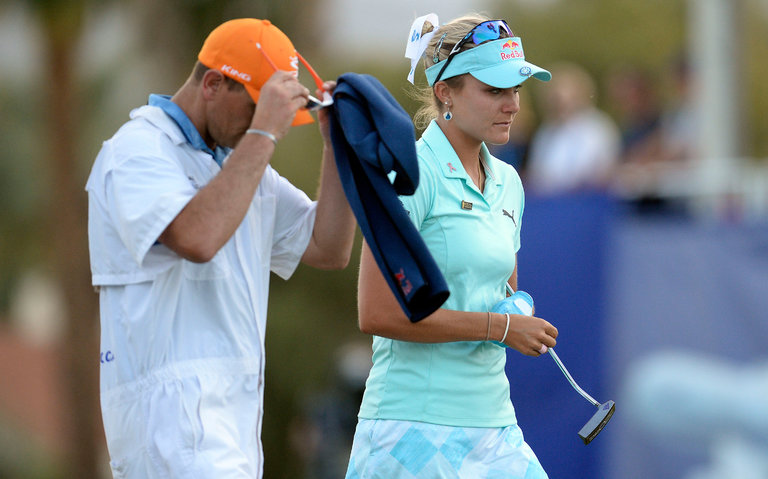Lexi Thompson Video Review Controversey
In an uncharacteristically fast response to the outrage expressed by players and fans over the Lexi Thompson controversy at the ANA Inspiration several weeks ago, the USGA and the R&A have released a new rules decision that limits the use of video evidence in assessing whether a player breached the rules.
However, the ruling does not address the major complaint in Thompson’s situation – the after-the-fact assessment of penalties based on reports by television viewers. The professional tours have established a working group to study that issue.
Thompson lost the ANA Inspiration after officials assessed a four-stroke penalty on the 13th hole in the final round based on a television viewer’s report that she improperly replaced her ball on the putting green the previous day. Video replay showed that Thompson unknowingly placed the ball no more than a half inch off her mark. At the time the penalty was assessed, Thompson had a three-stroke lead, and ultimately lost in a playoff.
Since the advent of HDTV, the role of video evidence has been a thorny problem in administering the rules of golf. The rules have always permitted officials to consider any relevant evidence, including input from spectators or video replays, in enforcing the rules. But slow motion, high definition video replays can permit officials to detect things that are not observable by players.
A notable example was a critical penalty assessed against Anna Nordqvist in the playoff during last year’s U.S. Women’s Open, after video revealed that she had very slightly brushed sand during her backswing in a bunker.
The USGA and the R&A had previously addressed video evidence in two rules decisions. In Decision 33-7/4.5, it was announced that the disqualification penalty for signing an improper scorecard may be waived if it is demonstrated that the player could not reasonably have been aware of facts resulting in a breach of the rules. Later, in Decision 18/4, it was ruled that a player is not penalized if the slight movement of his ball on the putting green is not discernible to the naked eye, but only through high definition video.
The new ruling (Decision 34-3/10) issued yesterday reinforces Decision 18/4, but goes further in announcing two standards that may be applied to limit the use of video: (1) when video reveals evidence that could not reasonably be seen with the naked eye, and (2) when players use reasonable judgment in determining locations in various situations required by the rules.
The reasonable judgment standard was incorporated in the proposed revisions to the rules of golf announced in March, scheduled to become effective in 2019. However, the new rules decision is effective immediately.
While recognizing that video evidence has a place in the enforcement of the rules, the decision notes that high resolution and slow motion video can undermine the integrity of the game by revealing facts that could not be identified otherwise. The ruling states that “such evidence should not be used to hold players to a higher standard than human beings can reasonably expected to meet.”
USGA executive director Mike Davis commented: “Advancements in video technology are enhancing the viewing experience for fans, but can also significantly affect the competition. We need to balance those advances with what is fair for all players when applying the rules.”
Under the new “naked eye” standard, where officials conclude that events (such as touching a few grains of sand in a bunker or a double-hit) could not reasonably have been seen with the naked eye and the player was not otherwise aware of a potential breach of the rules, no penalty will be assessed even if video technology shows otherwise.
The new “reasonable judgment” standard applies where players must determine a spot, point, position, line, area, distance, or other location on the course in applying the rules.
Examples include estimating where a ball last crossed the margin of a water hazard; estimating where to drop a ball in taking relief; or replacing a lifted ball. The ruling explains that, because such determinations must be made expeditiously but often cannot be precise, “players should not be held to the degree of precision that can sometimes be provided by video technology.”
Accordingly, so long as the player does what can be reasonably expected under the circumstances to make an accurate determination, his or her reasonable judgment will be respected even if later proven to be wrong by video evidence.
In making this determination, officials will consider the player’s actions and their context, the player’s explanation of his or her actions, information from other players or observers, and the degree to which the determination by the player deviated from the correct determination (taking into account the facts that some actions can be made with greater accuracy than others).
Decision 34-3/10 is a welcome and prompt step by the USGA and the R&A to address the vexing problem of video technology that has generated a number of significant rules controversies in recent years. However, it does not resolve the problem of viewer call-ins or the application of penalties after players have signed their scorecards.
A working group of officials from the LPGA, PGA Tour, PGA of America, PGA European Tour, and Ladies European Tour has been formed to study those issues.



